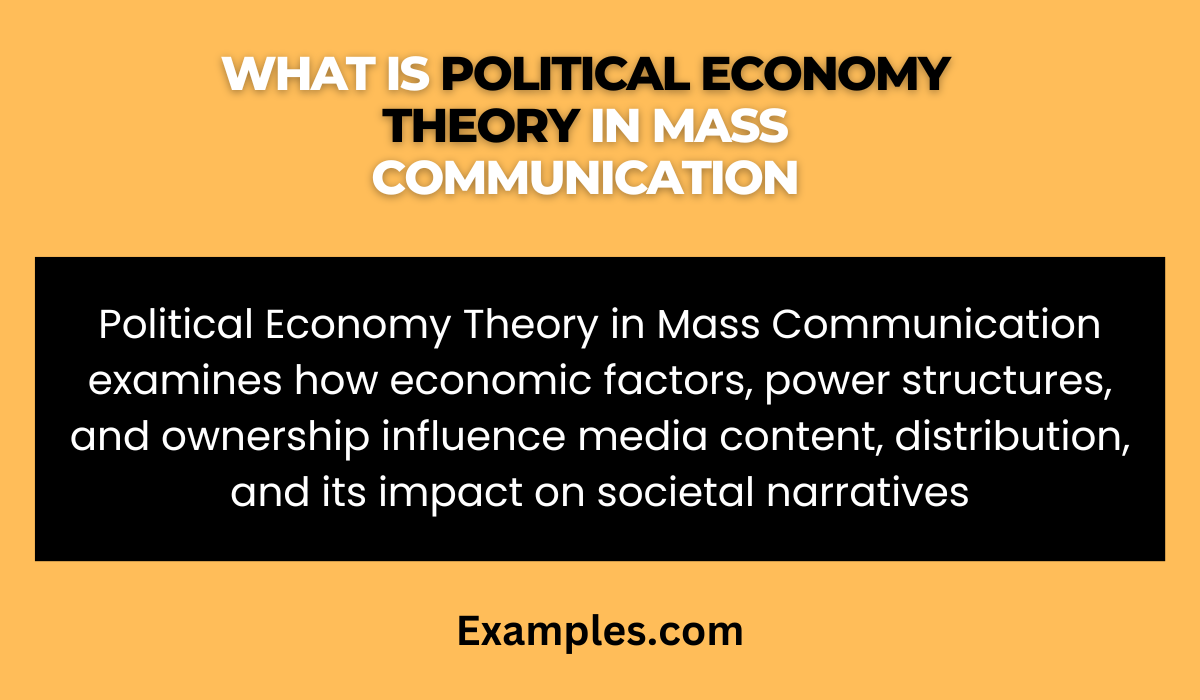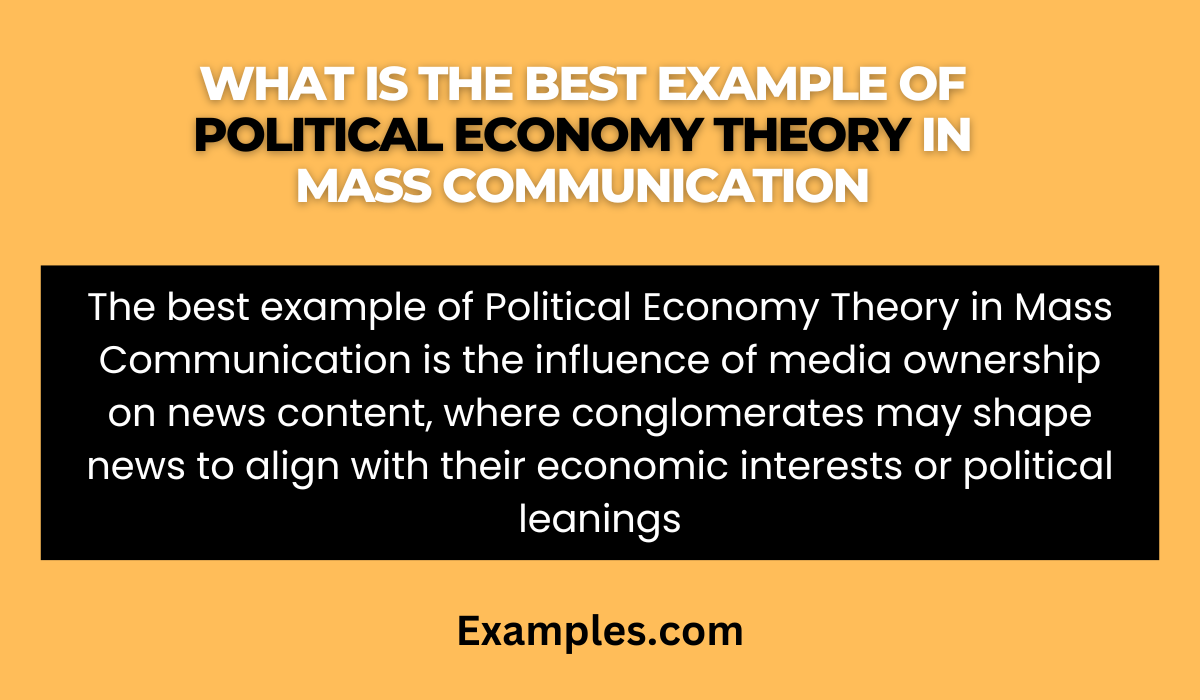30+ Political Economy Theory in Mass Communication Examples
The concept of Political Economy Theory in Mass Communication explores the intricate relationship between economic interests, political power, and how they influence media content and public communication. This theory delves into the ways mass media is used as a tool for promoting specific ideologies and maintaining existing power structures. It’s a critical lens through which we can understand the dynamics of media operations and content within the broader socio-economic and political contexts.
What is Political Economy Theory in Mass Communication
Political Economy Theory in Mass Communication examines the control and influence over media by corporate and governmental entities. It scrutinizes how ownership, advertising, market competition, and regulatory frameworks shape the news and information disseminated to the public. This theory underscores the notion that media content is not just a reflection of social realities, but also a product shaped by economic and political forces. By understanding this theory, one gains insight into the mass communication scenario and how it shapes public perception and discourse.

History of Political Economy Theory in Mass Communication
The roots of Political Economy Theory in Mass Communication can be traced back to the mid-20th century. Scholars began to question the influences of media ownership and the capitalist framework on the production of media content. This historical perspective reveals how the theory evolved in response to changing media landscapes, including the rise of broadcasting, digital media, and the global consolidation of media corporations. It provides a comprehensive view of how economic and political contexts have historically shaped mass communication examples in various eras.
What is the Best Example of Political Economy Theory in Mass Communication
One of the best examples of Political Economy Theory in Mass Communication is the analysis of news media coverage of political and economic issues. For instance, examining how major news outlets report on corporate scandals or economic policies can reveal biases and interests aligned with their owners or advertisers. This example demonstrates the theory’s relevance in analyzing the intersection of media, politics, and economics in shaping public understanding of crucial issues. It illustrates the theory’s practical application in critiquing and understanding the mass communication characteristics in real-life scenarios.
In conclusion, the Political Economy Theory in Mass Communication offers a critical framework for understanding how economic and political interests shape media content. This guide highlights the theory’s significance in analyzing the complex dynamics between media, society, and power structures. By exploring its history, key concepts, and practical examples, one gains a deeper insight into the role of mass communication in contemporary society.

30 Examples of Political Economy Theory in Mass Communication
Political Economy Theory in mass communication explores how economic factors and power structures influence media content and distribution. This theory highlights the significant role of mass communication in shaping societal narratives, particularly in a media-saturated world. It emphasizes the interplay between media ownership, advertising interests, and government regulations in crafting the media landscape.

- Media Ownership and News Content: Major news outlets, often owned by conglomerates, may skew news content to align with their economic interests or political leanings. For instance, a network owned by a large corporation may underreport issues that conflict with the corporation’s interests.
- Advertising Influence on Media: Advertising plays a crucial role in media funding. As such, media content, especially in commercial broadcasting and print media, is often tailored to attract advertisers, potentially leading to biased or sensationalized news.
- Government Regulation and Media: Government policies and regulations can significantly impact media content and distribution. For example, in countries with stringent media regulations, news may be censored or altered to favor government perspectives.
- Cultural Imperialism in Global Media: The dominance of Western media corporations in global media distribution illustrates cultural imperialism. This leads to a homogenization of cultural values and underrepresentation of local cultures in the media.
- Digital Media and Economic Models: The rise of digital media platforms like social media and blogs has shifted traditional economic models. These platforms often rely on user-generated content, altering the dynamics of content production and distribution.
- Public Broadcasting and Diverse Representation: Publicly funded broadcasters, unlike commercial media, are less influenced by corporate interests, allowing for more diverse and representative media content.
- Impact of Mergers and Acquisitions: Mergers and acquisitions in the media industry can lead to media consolidation, limiting diversity in viewpoints and reducing competition in the media landscape.
- Influence of Lobbying on Media Policy: Lobbying efforts by large media corporations can influence media policies and regulations, often swaying them in favor of big players and impacting media pluralism.
- Media as a Tool for Social Control: Media, controlled by dominant economic and political forces, can act as a tool for social control by shaping public opinion and reinforcing status quo ideologies.
- Role of Public Relations in Media: PR activities, funded by corporations or political entities, can significantly influence media narratives, often blurring the lines between objective reporting and corporate or political messaging.
- News Framing and Corporate Interests: News outlets might frame stories in ways that favor their parent company’s interests, subtly shifting public perception in line with these interests.
- Entertainment Media and Cultural Values: Mainstream entertainment media, often driven by profit motives, propagate specific cultural values and lifestyles, influencing societal norms and expectations.

- Social Media Algorithms and Engagement: Social media platforms use algorithms designed to maximize user engagement, often promoting sensational or polarizing content that aligns with business objectives.
- Telecommunication Policies and Access: Government telecommunication policies can dictate who has access to media, affecting the diversity and reach of mass communication.
- Media Blackouts in Crisis Situations: In certain political or economic crises, media blackouts imposed by those in power prevent the dissemination of information, showcasing the control of media for political gains.
- Infotainment and News Quality: The trend of infotainment, where news is mixed with entertainment, often dilutes the quality of news, catering to audience preferences and commercial interests rather than journalistic integrity.
- Online News Aggregators and Ad Revenue: Websites that aggregate news content often prioritize stories that generate more clicks and ad revenue, which can lead to biased or unbalanced news coverage.
- Product Placement in Media: Product placement in films, TV shows, and online content illustrates how commercial interests infiltrate content creation, subtly influencing consumer behavior.
- Media Concentration and Pluralism: The concentration of media ownership in the hands of a few conglomerates reduces the plurality of voices and perspectives in the media, affecting democratic discourse.
- Influence of Market Research on Content: Media content, especially in television and radio, is often shaped by market research to cater to specific demographics, influencing the diversity and type of content produced.
- Economic Censorship in Journalism: Economic pressures can lead to self-censorship among journalists, who may avoid reporting on topics that could upset advertisers or owners.
- Global News Coverage and Economic Interests: The focus of global news coverage often mirrors the economic interests of the country where the media is based, leading to a skewed representation of international events.
- Media as a Platform for Political Propaganda: In some cases, media is used as a platform for political propaganda, where content is manipulated to support the agenda of political groups or governments.
- Deregulation and Media Diversity: Deregulation in the media sector can lead to decreased diversity in media ownership, as larger companies buy out smaller ones.
- Digital Divide and Information Access: The digital divide, exacerbated by economic disparities, affects who has access to online mass communication platforms, impacting the democratization of information.
- Media and Consumer Culture: Mass media plays a significant role in promoting consumer culture, often prioritizing content that supports consumerist values aligned with advertiser interests.
- Satellite Television and Cultural Penetration: Satellite television allows for the penetration of foreign media into different cultures, often leading to the dominance of certain cultural values over others.

- Media Monopolies and Political Influence: Media monopolies can exert significant influence on political processes, swaying public opinion in favor of certain policies or candidates.
- Sponsorship in Sports Broadcasting: Sponsorship deals in sports broadcasting show how commercial interests can dictate the presentation and coverage of sports events in the media.
- Media Representation and Social Inequality: The representation of different social groups in media often reflects economic inequalities, with marginalized groups receiving less coverage or stereotypical portrayal.
Role of Political Economy Theory in Mass Communication
Political economy theory plays a pivotal role in understanding the dynamics of mass communication. It offers a framework for analyzing how economic and political factors shape the production, distribution, and consumption of media content. By exploring the intricate relationships between media, power, and society, this theory helps in comprehending how media serves as a tool for both empowerment and manipulation.
- Ownership and Control: It scrutinizes how ownership of media outlets influences the content, pushing specific agendas and ideologies.
- Regulatory Frameworks: Examines the impact of government regulations and policies on media operations and content.
- Economic Pressures: Focuses on how market forces and advertising revenue dictate media content and formats.
- Ideological Biases: Analyzes the role of media in reinforcing or challenging prevailing social and political ideologies.
- Globalization of Media: Evaluates the effects of global media conglomerates on local cultures and societies.
- Technological Advancements: Considers how technological changes, such as digital media, reshape media landscapes.
- Public Sphere Participation: Investigates media’s role in facilitating or hindering public discourse and democratic participation.
- Cultural Production and Reproduction: Looks at how media content reflects and influences cultural norms and values.
- Media Access and Diversity: Addresses issues of access to media and the representation of diverse groups in media content.
- Power Dynamics: Studies the interplay between media, state, and corporate powers in shaping public opinion.
Importance of Political Economy Theory in Mass Communication
The importance of political economy theory in mass communication is multifold, offering insights into how media functions within and impacts society.
- Critical Understanding of Media: It enables a deeper understanding of the underlying economic and political forces driving media content.
- Democratization of Media: Advocates for more equitable media systems that serve public interests over private gains.
- Media Literacy: Enhances media literacy by enabling audiences to critically analyze media content and its purposes.
- Informed Policy Making: Guides policymakers in creating regulations that foster diverse and independent media.
- Advocacy for Diversity: Promotes diversity in media ownership and content, ensuring varied perspectives.
- Understanding Media Biases: Helps in identifying and challenging biases and stereotypes perpetuated by mainstream media.
- Global Media Dynamics: Provides a framework for understanding the complexities of global media influences and interactions.
- Resistance to Monopolization: Challenges the concentration of media ownership and encourages alternative media sources.
- Ethical Media Practices: Promotes ethical practices in journalism and mass communication.
- Enhancing Public Discourse: Contributes to richer public discourse by encouraging media to address varied societal issues and voices.
How to use Political Economy Theory in Mass Communication
Incorporating political economy theory into mass communication practices is essential for creating more informed, ethical, and socially responsible media.
- Content Analysis: Utilize the theory to analyze and critique media content for biases and underlying agendas.
- Media Education: Embed political economy perspectives in media education to cultivate critical thinking among future media professionals.
- Policy Advocacy: Use the theory to advocate for media policies that promote diversity, equity, and democratic values.
- Ethical Reporting: Encourage journalists to be aware of economic and political influences on their reporting.
- Diverse Media Creation: Support and create media outlets that offer alternative perspectives to mainstream narratives.
- Public Awareness Campaigns: Conduct campaigns to educate the public about media ownership and its impacts.
- Research and Scholarship: Advance research in political economy to deepen understanding of evolving media landscapes.
- Community Media Support: Promote and support community and independent media initiatives.
- Global Media Collaborations: Engage in global collaborations to address and resist homogenizing effects of global media.
- Social Media Activism: Utilize social media platforms to challenge dominant media narratives and provide counter-narratives.
The Political Economy Theory explores the intricate interplay between economic interests and media structures. This theory posits that mass media is not merely a neutral conveyor of information but is significantly influenced by corporate and governmental entities. It emphasizes how these power dynamics shape the content, distribution, and audience reception in mass communication contexts. Understanding this theory is crucial for grasping the real-life implications of media on society and the potential biases in media narratives.



